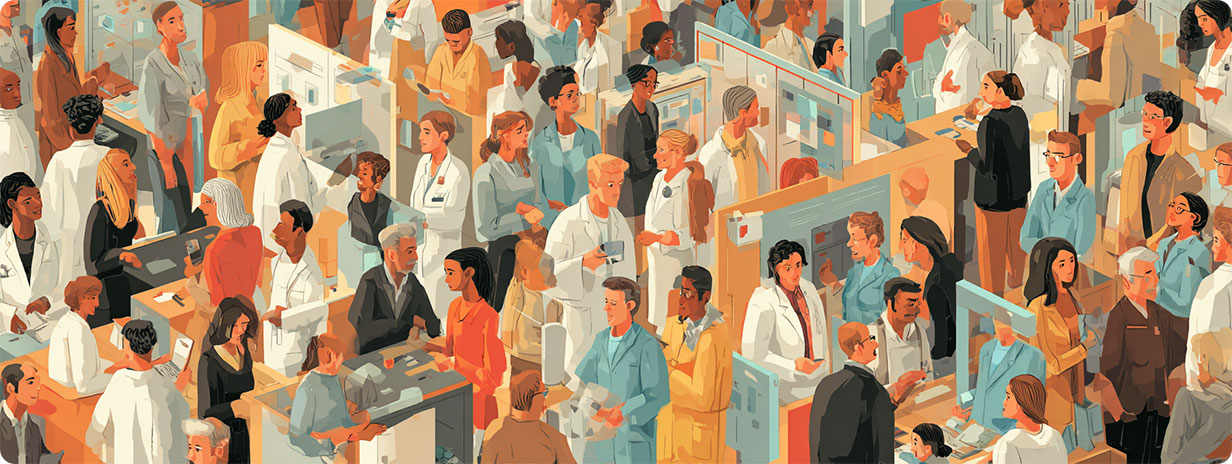This week’s HLTH 2025 was the annual event’s biggest and most ambitious showing to date, with more than 12,000 pharma leaders, brand marketers, technologists, healthcare providers and investors descending on Las Vegas to chart the future course of health-tech. In its wake, we asked a host of attendees from life sciences companies to answer three questions about their experience. Here’s what the first wave of respondents shared with us; we’ll add more responses as they arrive.
What was your biggest takeaway from HLTH? What stood out as the most compelling or unexpected insight?
Geetha Parachuru, director of commercial digital products, Gilead Sciences: Walking the HLTH floor this year felt like Groundhog Day. It was the same feeling you get when a new parent swears they’ll never let their kids use screen time: Wide-eyed, well-intentioned and certain they’re different, until they find themselves fighting for survival. Health tech still has that energy, optimism with a side of naivete. I say that with love.
But the real relief came from the familiar faces, the ones who lived through the post-pandemic hangover. The ones who watched valuations vanish overnight and unit economics corrode at scale. What I loved most this year was that we all seemed to recognize each other. It’s like we’ve developed radar.
In product management, we say, “Think strategically, act tactically.” That mindset finally showed up at HLTH. The talks were practical. The buzz around AI was everywhere, but this time the question wasn’t if to use it, but where it actually belongs. People talked about where tools live in the day-to-day: inside scheduling, intake, billing, prior authorization and call centers. The bet now is on automating the invisible work, like ambient notes that cut charting time, cleaner coding and claims, fewer denials, faster authorizations and lighter inboxes. That’s where money and morale are saved.
The floor itself told a story: Fewer booths, smaller crowds. Before the pandemic, it was crowded with hype. This year felt calm and reflective. The OGs are back.
Adama Ibrahim, VP, research and early development, digital transformation, digital strategy and insights, Novo Nordisk: My biggest takeaway was the mainstream adoption of AI approaches across all stakeholder groups, including startups, to address care delivery, research and clinical trials as well as health equity and women’s health. For the first time I am hearing deep and meaningful conversations about defining and changing workflows. This is the paradigm shift needed to transform our industry and achieve the best patient outcomes.
Jeff Caron, chief digital and technology officer, Patient Care Solutions, GE HealthCare: The dominant theme was AI’s maturation in healthcare. While AI has been a headline topic for years, this year’s conversations shifted from hype to practicality and trust-building. Leaders emphasized moving beyond flashy demos toward clinician-centric solutions, regulatory clarity, and measurable outcomes. For example, generative AI is being integrated into workflows like ambient clinical documentation and decision support.
There’s growing recognition that AI’s short-term impact may be overstated, but its long-term potential is underestimated, especially in diagnostics and operational efficiency. As for an unexpected insight, it’s that AI tools are showing empathetic responses in patient interactions, challenging assumptions about technology’s role in humanized care.
Dr. Shakira Grant, former health policy advisor to the U.S. House of Representatives Ways and Means Health Sub-Committee: One takeaway is the sheer number of stakeholders it takes to move real healthcare innovation. It’s easy to operate in a silo, whether your specialty or your product or your clinic, and forget the full cast it takes to bring new technologies to life. Clinicians, patients, payers, tech developers, policymakers, funders, investors… every one of them is essential. HLTH underscored that innovation only scales when the entire ecosystem is engaged and aligned.
Benjamin Suhr, partnership and commercialization lead, Novo Nordisk, and co-founder, Osaia Health: AI is everywhere, but few big-scale examples were presented. I had expected more in-depth and large-scale cases to be presented. Also, wearables are picking up and getting a more significant role in healthcare – and not only in consumer health.
What were people talking about most, both in sessions and in/around the event venues?
Grant: The intentional spotlight on women’s health and on women leading innovation. In a sector where women are still underrepresented in tech roles, leadership and funding, HLTH made women’s health a front-and-center priority. It wasn’t performative. We saw women stepping up to tackle issues long treated as taboo or too easy to sidestep, and doing it with real momentum. That deliberate focus felt overdue and genuinely catalytic.
Caron: Across sessions and networking spaces, three topics dominated. Artificial intelligence was everywhere, from clinical documentation and imaging to predictive analytics and patient engagement. Conversations focused on accuracy, bias mitigation and clinician trust, as well as partnerships with big tech (Microsoft, Nvidia, GE HealthCare).
There was a lot of talk about GLP-1 weight loss drugs, as their cost, access challenges and potential $100B market impact sparked debates on affordability and payer strategies. As for women’s health and equity, federal funding announcements and celebrity advocacy (e.g., menopause research) highlighted a push to close historic investment gaps. Other recurring threads included health equity, prior authorization reform and food-as-medicine models.
Suhr: They were talking about how GLP-1s are making headlines, and how all the big consumer health companies are moving into this area.
Parachuru: If you listened closely, the OGs at HLTH weren’t reminiscing; they were recalibrating. Everyone knows ambient scribing is cutting charting time in half, but the people who have lived in this system are already thinking a step ahead. What happens when you free up that much clinician time? Where do those minutes go? And if automated prior authorizations are turning fax nightmares into five-minute wins, what does that do to payers who still process approvals in batches or rely on half-manual workflows?
That’s how operators think. Every gain on one side creates pressure on the other. Efficiency doesn’t exist in isolation; it ripples through scheduling, billing and utilization review.
The next play isn’t about building more tech to arm-wrestle payers. It’s about tech that actually bridges them. The smartest operators know the real savings come from preventing friction before it starts – such as systems that flag denials before they hit the queue, or tools that keep patients on therapy so that claims don’t bounce back for non-adherence. Companion apps are evolving from engagement tools to an entire operational infrastructure that patients would find incredibly useful in the face of a fragmented healthcare system. What we should aim for is a digital front door where revenue integrity, patient adherence and care coordination finally coalesce. These are the problem sets that need to be studied before applying AI into the conversation.
That’s what the best conversations at HLTH sounded like this year. Less buzz and more insightful one-to-ones. To my village at HLTH this year, you know exactly who you are.
What was the overall tenor of the event? Did you sense optimism about healthcare’s direction, anxiety about obstacles ahead or a more measured outlook?
Craig Lipset, co-chair of the Decentralized Trials and Research Alliance (DTRA) and former head of clinical innovation, Pfizer: There seemed to be a very wide gap between what was being said on stage and in booths versus what people were saying in conversations during asides. That’s not surprising – innovation is exciting, change is hard.
Caron: The mood was cautiously optimistic. I sensed a strong belief in AI’s transformative potential and bold moves toward action-oriented healthcare. Many leaders framed this as an inflection point for delivering tangible results rather than future-gazing.
At the same time, there was an acknowledgment of hurdles, ranging from regulatory uncertainty and clinician burnout to affordability concerns for breakthrough therapies. Conversations were pragmatic, focusing on implementation, interoperability and trust rather than moonshots. I also sensed some underlying anxiety, with policy shifts (e.g., Medicaid cuts, NIH funding changes) and economic pressures adding a layer of concern, especially for access and sustainability.
Suhr: I would say that the optimism is always there with this crowd of innovators. But I could also feel a more measured outlook due to the uncertainties with the current U.S. government and how it will influence the health system.
Grant: The mood? Globally energized and notably optimistic. Even with uncertainty around research funding and politics, there was a clear willingness to collaborate and an understanding that, if we work together now, we can unlock the real potential of AI and the broader wave of innovation sweeping through healthcare.
What dominated the conversation? Artificial intelligence, full stop. And it wasn’t just parsing definitions of AI versus machine learning versus agents – it was AI as a whole and its velocity. People were talking about how it is reshaping care delivery, rethinking how we measure outcomes and accelerating what’s possible today and in the near future.




